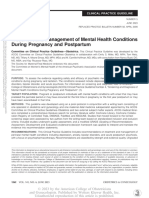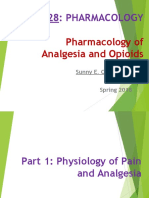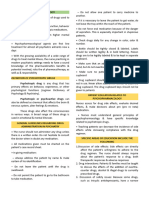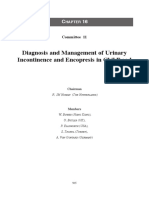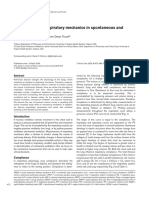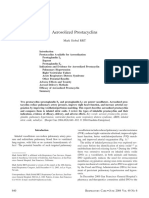Intrathecal Morphine
Intrathecal Morphine
Uploaded by
Joana MoreiraCopyright:
Available Formats
Intrathecal Morphine
Intrathecal Morphine
Uploaded by
Joana MoreiraOriginal Description:
Copyright
Available Formats
Share this document
Did you find this document useful?
Is this content inappropriate?
Copyright:
Available Formats
Intrathecal Morphine
Intrathecal Morphine
Uploaded by
Joana MoreiraCopyright:
Available Formats
PAIN Tutorial 347
INTRATHECAL OPIOIDS
Dr David Cosgrave1, Dr Enda Shanahan1, Dr Niamh Conlon2
1
Anaesthesia SpR St Vincent's University Hospital, Dublin, Ireland
2
Consultant Anaesthetist St Vincents University Hospital, Dublin, Ireland
Edited by
Dr Muralidhar Joshi
Consultant Anaesthetist, Kamineni Hospitals, Hyderabad, India
Correspondence to atotw@wfsahq.org 21st Feb 2017
QUESTIONS
Before continuing, try to answer the following questions. The answers can be found at the end of the article, together
with an explanation. Please answer True or False:
1. Regarding the pharmacodynamics and mechanism of action of intrathecal (IT) opioids:
a. Opioids increase calcium entry which hyperpolarises the nerve cell.
b. Nerve cells are more likely to transmit a signal after an opioid has bound to it.
c. Fentanyl has a fast onset of action because it is highly spinal selective.
d. Morphine has a slow onset of action because it is lipophilic.
e. Fentanyl has a short duration of action because it remains fixed in the CSF.
2. Regarding clinical uses of intrathecal opioids
a. Fentanyl has been shown to increase the duration of motor block.
b. Intrathecal morphine is a safe and effective analgesic option for day case surgery.
c. Intrathecal morphine at doses of 100200mcg are safe and effective in major joint replacement surgeries.
d. In thoracic surgery, intrathecal morphine should be considered a 2nd or 3rd line analgesic option.
e. High dose intrathecal morphine improves outcome in major abdominal surgery.
3. Adverse events with intrathecal opioids
a. Intrathecal fentanyl causes delayed respiratory depression at 6-10 hours after administration.
b. Severe respiratory depression caused by intrathecal morphine can be managed with naloxone infusion.
c. Pruritus can be treated with antihistamines.
d. 5HT3 antagonists are beneficial for treatment of IT opioid induced nausea and vomiting and has the added
effect of reducing pruritus.
e. Urinary retention is a dose dependent side effect of intrathecal morphine.
Key Points INTRODUCTION
Intrathecal opioids are useful agents in acute Spinal anaesthesia is when local anaesthetic is injected
pain management intrathecally (i.e. into the cerebrospinal fluid in the subarachnoid
space) to establish a spinal block and facilitate a surgical
Lipophilic opioids such as fentanyl have rapid procedure. Equally, opioids can be injected intrathecally either as
onset but short duration of action single agents (e.g. major abdominal surgery under general
Hydrophilic drugs like morphine have a slow anaesthesia) or as an adjunct to local anaesthetic, producing a
onset, longer duration of action but greater risk better quality block and prolonged analgesia post operatively. This
of delayed respiratory depression tutorial aims to explore the benefits and potential adverse effects
when opioids are administered intrathecally.
Other common side effects include pruritus,
nausea and vomiting and urinary retention Historical Background
Doses of intrathecal morphine > 300mcg pose During the mid to late 19th century, as the world of anaesthesia
greater risk of respiratory depression was evolving, interest developed in the spinal cord as a potential
Patients receiving intrathecal morphine should analgesic target. James Leonard Corning and August Bier led the
be closely monitored in the first 24 hours
way in neuraxial blockade with the use of cocaine, while Bier
successfully performed surgery under neuraxial block in Kiel in
postoperatively 1
1898 .
Subscribe to ATOTW tutorials by visiting www.wfsahq.org/resources/anaesthesia-tutorial-of-the-week
st
ATOTW 347 Intrathecal Opioids (21 Feb 2017) Page 1 of 6
In Paris in 1901 Nicolae Racoviceanu-Piteti first described of the use of opioids injected intrathecally for the purpose of
analgesia. However it wasn't until the 1970s that the field really expanded. Opioid receptors were identified in the dorsal
horn of the spinal cord and were subsequently proven to modulate nociceptive input. Notably in 1979 Wang described
2
the successful use of intrathecal morphine in a cohort of eight patients with genitourinary malignancies .
Since this time the number of reports, studies and review articles on this subject has grown steadily, reflecting the sum of
our clinical experience and our ever improving neuro-pharmacological understanding of the spinal cord as an analgesic
target.
PHARMACOLOGY OF INTRATHECAL OPIOIDS
Mechanism of action
The fundamental effect of an opioid binding to its receptor in the spinal cord is to decrease, or turn off, a passing
nociceptive signal. While they also modulate the pain pathway in the midbrain by influencing the descending pathways, it
is this signal blocking aspect that is integral to their effect. Of note there are many more opioid receptors located pre-
synaptically than post-synaptically.
The opioid receptors (Mu, Delta and Kappa) are all G-Protein linked and they achieve their signal-reducing effect in the
following ways:
a) Decrease presynaptic Ca++ entry inhibits transmitter release
b) Increase postsynaptic efflux of K+ hyperpolarises cell
c) Inhibit adenylate cyclase inhibits transmitter release
Thus opioids essentially decrease release of excitatory transmitters (e.g. glutamate and substance P) and create
conditions where the nerve cell is less likely to depolarise and thus transmit the nociceptive signal. Inhibitory transmitters
such as glycine and gamma amino butyric acid (GABA), however, also play a role in opioid mediated analgesia,
specifically by activating descending inhibitory pathways. A detailed description of the complex system of receptors and
transmitters involved in pain transmission are beyond the scope of this article.
Pharmacodynamics
A thorough understanding of the pharmacodynamic properties of the various opioids, and the differences between them,
informs us of their efficacy and most troublesome adverse effects. The most clinically relevant property of the drug is the
2
degree of lipophilicity . The table below compares the properties of fentanyl and morphine, the most commonly used
agents.
Drug Fentanyl Lipophilic Morphine Hydrophilic
Onset Fast (10-20 min) Slow (60 min)
Rostral Spread Minimal Significant
Duration of Action Short (4-6 hrs) Long (18-24 hrs)
Time of Respiratory Depression 0-1 hr Up to 24 hrs
Table 1. Comparison of lipophilic and hydrophilic opioids
Once injected into the cerebrospinal fluid, lipophilic fentanyl rapidly diffuses into neuronal tissues, binding with high
affinity to receptors and producing a rapid onset of action. This lipophilic agent, however, also diffuses rapidly into non-
neuronal tissues such as myelin and epidural fat, causing CSF concentrations to fall quickly, shortening duration and
limiting spread towards the patients head. This is in contrast to morphine, which, being hydrophilic, maintains its
concentration in the CSF for longer giving a longer duration of action and more analgesic spread above the injection
point. This greater spread superiorly, can be a benefit clinically as it provides a wider area of analgesic coverage.
2
However the slower onset and prolonged action are potentially associated with delayed respiratory depression .
Ideally, opioids injected intrathecally would display spinal selectivity i.e. provide the benefit of analgesia at the spinal
level without the problems of respiratory depression at the systemic level. However, Barnards demonstrated that a large
3
part of the analgesic effect of intrathecal opioids arises from their systemic effect, especially for the lipophilic agents .
Spinal Selectivity Opioid
High Morphine; Diamophine
Moderate Fentanyl; Sufentanil
Low Alfentanil
3
Table 2. Spinal Selectivity of different opioids .
Subscribe to ATOTW tutorials by visiting www.wfsahq.org/resources/anaesthesia-tutorial-of-the-week
st
ATOTW 347 Intrathecal Opioids (21 Feb 2017) Page 2 of 6
CLINICAL USES OF INTRATHECAL OPIOIDS
There are a number of indications for intrathecal opioids. We will discuss its use during the peri-operative period for
acute pain management and also briefly its use in the treatment of chronic cancer pain. Of note, only preservative free
opioids should be used for injection into the CSF.
Day case surgery
The most commonly used intrathecal opioid in the day case setting is fentanyl, which has a synergistic effect with local
anaesthetic agents, and has been shown to improve the quality of the block and have some post-operative analgesic
effects. It does not prolong the duration of block and there is no association with delayed respiratory depression.
Intrathecal morphine is contraindicated in day case surgery due to the risk of delayed onset respiratory depression.
Major joint replacement
Intrathecal morphine (ITM) has been shown to be safe and effective when used as an adjunct to local anaesthetic in
spinal anaesthesia for lower limb joint replacement. Studies have demonstrated that doses of 100-200 mcg improve
patient satisfaction and decrease morphine PCA usage in patients undergoing total hip replacements (THR). The main
clinically relevant side effect is pruritus. Doses should be adjusted for individual cases and a dose at the lower end of the
range (i.e. 100mcg) should be considered in older patients. Frassanito et al have shown ITM to be better than single
shot femoral nerve block at reducing pain scores and supplemental morphine usage for patients having total knee
replacements (TKR). In general, the analgesic requirements after TKR are higher than THR. However many authors
4, 5
have advised against an ITM dose greater than 300mcg in this patient population. At doses above 300mcg, the risk of
nausea, pruritus, urinary retention and respiratory depression exceed the analgesic benefit.
Obstetric practice
The use of intrathecal morphine and fentanyl is very common in caesarean section patients. Generally the dose used is
100mcg of morphine as a single dose added to the local anaesthetic in spinal anaesthesia. Doses higher than this have
resulted in higher incidence of side effects with minimal benefit in terms of quality of analgesia. Some centres utilise
fentanyl as a co-adjuvant. Fentanyl has been shown to decrease the dose of local anaesthetic required and improve the
quality of the block.
Urology
In urology surgery, ITM has been shown to be effective at doses of 50-300mcg, depending on the procedure. In patients
undergoing transurethral resection of prostate (TURP), as little as 50mcg of ITM added to local anaesthetic for spinal
anaesthesia has been shown to be effective in decreasing detrusor muscle spasm post operatively. Multiple studies have
shown a decrease in supplemental analgesic requirements in the first 24 hours post operatively in patients undergoing
radical retropubic prostatectomy. In nephrectomy, doses of 300 500mcg of intrathecal morphine have been shown to
be provide effective analgesia. However, as mentioned previously the side effect profile at doses >300mcg needs to be
4,5
considered. These studies have also shown an increased time to first use of supplemental analgesia.
Major laparotomy
ITM has shown a definite reduction in pain scores in patients undergoing major abdominal surgery in the first 24 hours.
However, postoperative pain tends to last greater than 24 hours and the analgesic effect, and opioid sparing effect
6
seems to be limited to the first 24 hours. ITM alone has not been shown to decrease hospital length of stay, but may
have benefit as part of a multimodal rehabilitation regime Those that advocate the use of ITM in laparotomy generally
agree that higher doses are required than in pelvic and orthopaedic lower limb surgery. Reported doses have ranged
from 300-400mcg up to as high as 7-10mcg/kg body weight. However, dose finding studies have failed to definitively
establish the optimal analgesic dose with the lowest serious side effect profile e.g. respiratory depression. Some
recommend never exceeding 300mcg ITM for avoidance of respiratory depression but this dose is unlikely to provide
effective analgesia for upper GI, hepatobiliary or major bowel surgery.
Thoracotomy
Patients undergoing thoracotomy have been shown to achieve better analgesia with the use of ITM along with IV PCA
compared to PCA alone. However, thoracic epidural analgesia or paravertebral catheter seem to provide more effective
analgesia over a more prolonged period of time with lower risk of respiratory depression. The decrease in the pain visual
analogue scale (VAS) scores with ITM in this population does not appear to be greater than with simple analgesics such
as paracetemol and NSAIDs. Therefore in thoracic surgery, ITM is recommended as a co-analgesic with paravertebral
catheters or as a second line technique where an epidural is contraindicated or not technically possible.
Spinal surgery
Studies have shown ITM to be very effective in control of pain post major spinal surgery. 3-5mcg/kg as recommended by
Raw et al, alongside IV PCA, has been shown to provide effective analgesia for this often painful procedure while
7
minimising the risk of respiratory depression.
Subscribe to ATOTW tutorials by visiting www.wfsahq.org/resources/anaesthesia-tutorial-of-the-week
st
ATOTW 347 Intrathecal Opioids (21 Feb 2017) Page 3 of 6
Fentanyl Morphine
Day case surgery 5 15mcg* Contraindicated
Major Joint Replacement +/- 5 15mcg* 100 200mcg*
Obstetric Practice 10 - 15mcg* 100 - 150mcg*
Urology 5-15mcg* 50mcg* for TURP
100 - 300mcg for major urology
Major Laparotomy Usually not used 300mcg up to 7 - 10mcg /kg**
Thoracotomy Usually not used Not a first line analgesic technique.
Up to 10mcg/kg where PVB / epidural is
contraindicated or failed**
Spinal Surgery Usually not used Under direct vision at end of surgery or as
a single shot spinal injection pre-
operatively. 3 - 5mcg/kg**
Table 3. Suggested doses of intrathecal opioids for different types of surgeries. *concomitant use of local anaesthetic for a spinal block
(TURP= Transurethral resection of prostate, PVB= paravetebral block) ** Any patient receiving doses > 300mg ITM should be
monitored in a high dependency setting for respiratory depression for at least 24 hours. for perioperative analgesia in patients
undergoing GA
Chronic Cancer Pain
According to the American Cancer Society, up to 75% of patients diagnosed with cancer suffer from pain at some stage
8
over the course of their disease. This pain tends to increase over time in patients where the disease is progressive and
not amenable to curative treatment. This progressive debilitating pain can lead to depression, and is often inadequately
treated. Morphine is the most commonly used opioid in this setting, with hydromorphone as an alternative if morphine
has been found to be ineffective or isnt tolerated. In the setting of refractory pain, or in patients with intolerable side
8
effects from systemic administration, intrathecal delivery can be an alternative. The mode of delivery is variable. Many
institutions will begin treatment with a one-off intrathecal injection, or a disposable short-term intrathecal catheter. This is
usually followed by a long-term tunnelled intrathecal catheter, or, if duration of treatment is expected to be prolonged, an
8
implantable pump device which can be refilled and programmed to deliver the infusion at different rates. The opioid of
choice is titrated to effect and individualised to the patient so guideline doses are not practical. Opioid can also be
combined with a low dose of local anaesthetic agent, alpha agonists (Clonidine), GABA agonists (pregabalin) or other
agents (ketamine). This however is beyond the scope of this article. Similar side effects to perioperative use can occur
and are discussed in the next section. The additional risks of haematoma and / or infection at the site of the pump or
worse, in the subarachnoid space, are rare but need to be considered.
COMPLICATIONS OF INTRATHECAL OPIOIDS
As with all routes of administration, opioids exert beneficial analgesic effects but at the cost of potentially serious side
effects. Respiratory depression and, more specifically with ITM, delayed respiratory depression are the most feared
complication of intrathecal opioids. A large meta-analysis of trials of intrathecal morphine showed a high risk of
6
respiratory depression, with an odds ratio of 7.86 and a NNH of 15. However, while some patients required naloxone to
maintain adequate ventilation, no patients required intubation. It is worth noting that the trials assessed for respiratory
depression were heterogenous, and the overall risk at doses over 300mcg is not known. Jacobsen et al demonstrated a
respiratory depression incidence of 60-100% in patients receiving 1-2.5mg IT morphine. The definition of respiratory
depression is not uniform across published literature, making it difficult to ascertain the true incidence.
Table 1 shows the timing of onset and duration of respiratory depression with the main IT opioids in common clinical use.
This explains the reasoning behind avoiding intrathecal morphine in day case surgery. Detection of respiratory
depression can be difficult as both the respiratory rate and tidal volumes can be affected to differing degrees. Some
patients may have a normal respiratory rate but a rising carbon dioxide level while others may have low respiratory rate
2
with normocarbia due to increased tidal volumes. Pulse oximeter monitoring will detect a desaturating patient but will not
show hypercarbia. However, this effect seems to be most pronounced with intrathecal doses higher than 300mcg. It
therefore seems reasonable to not exceed this dose in patients who would not otherwise have blood gas analysis carried
out in the 24 hours postoperatively. Risk factors for respiratory depression include increasing age (> 65 years), use of
ITM dose exceeding 300mcg, and concomitant opioid use via another route. The ASA guidelines for detection and
treatment of respiratory depression due to neuraxial opioid recommend hourly monitoring for 12 hours post
9
administration of ITM and 2 hourly for the following 12 hours. Following the first 24 hours the duration and frequency of
9,10
monitoring should be dictated by the patients clinical condition. Generally, the use of routine supplemental oxygen is
9
not recommended in the absence of hypoxia as it may mask respiratory depression and a rising carbon dioxide level.
Pruritus is an extremely common side effect with intrathecal opioids and as with other side effects, can be prolonged with
ITM. Studies have shown an incidence ranging from 5.1% to as high as 85%. This can be treated with antihistamines
although their usefulness for this particular cause of pruritus is questionable. Some have advocated the use of
ondansetron as an effective anti-pruritic in this population. With intrathecal morphine, doses of naloxone under
2mcg/kg/hr as an infusion have been shown to be effective in treating pruritus in some studies and not affect the quality
of analgesia. Sub hypnotic doses of propofol have also been shown to be effective in treating pruritus in these patients.
Subscribe to ATOTW tutorials by visiting www.wfsahq.org/resources/anaesthesia-tutorial-of-the-week
st
ATOTW 347 Intrathecal Opioids (21 Feb 2017) Page 4 of 6
Complication Incidence
Respiratory Depression Frequent (up to 7%)
Pruritus Very common (5.1 37%)
Urinary Retention Likely increased but incidence is
unreliable as many patients were
catheterised perioperatively
Nausea and Vomiting Very common (25%)
Table 4: Complications of intrathecal opioids
Urinary retention is thought to be common with intrathecal morphine but not with lipophilic opioids. A meta-analysis in the
British Journal of Anaesthesia showed a slight increase in incidence with intrathecal opioid used for major surgery
6
without local anaesthetic. Given the risk of detrusor muscle damage from an undiagnosed distended bladder, patients
should be monitored for urinary retention and catheterised if it occurs.
Nausea and vomiting is associated with opioid use regardless of the route of administration. Studies have been
equivocal about whether intrathecal opioids specifically cause an increase in incidence compared to other routes of
6
administration. Lipophilic opioids such as fentanyl and sufentanil seem to be non-causative. Incidence of nausea and
vomiting in ITM, on the other hand, is equivalent to that seen in systemic administration. Therefore standard treatment
and prophylaxis for opioid induced nausea and vomiting are advised. The 5HT3 antagonist ondansetron may be
particularly useful due to its added benefit of potentially reducing IT morphine induced pruritus.
The other side effects of sedation, delayed gastric emptying and sweating are probably no more an issue than with
systemic opioids.
Some studies have advocated the use of naloxone infusion as a routine measure to reduce the incidence of respiratory
depression and also of other adverse events. Further studies are required to assess if naloxone can be administered in a
dose which results in a decrease in adverse events, specifically respiratory depression, without compromising the quality
of analgesia. Further study may reveal this to be an effective method for allowing ward level care in patients receiving
high dose intrathecal morphine. However, that evidence is not yet clear and patients who have received >300mcg ITM
should be nursed in a high dependency setting, with a high staffing ratio and frequent or continuous monitoring for the
first 24 hours post administration.
ANSWERS TO QUESTIONS
1. Regarding the pharmacodynamics and mechanism of action of intrathecal opioids?
a. False Binding of opioid receptors lead to a decrease in calcium influx and an increase in potassium efflux.
It is the latter mechanism that causes hyperpolarisation of the cell.
b. False Binding of opioid causes hyperpolarsation of the cell, thereby decreasing signal transmission.
c. False Fentanyl has moderate spinal selectivity
d. False Morphine is a hydrophilic opioid, fentanyl is lipophilic.
e. False Fentanyl is lipophilic, allowing binding to neuronal and vascular tissue and thereby rapidly
decreasing the CSF concentration.
2. Regarding the clinical uses of intrathecal opioids
a. False Fentanyl improves quality of analgesia without prolonged motor block
b. False IT morphine is considered contraindicated in day case surgery due to the risk of delayed onset
respiratory depression.
c. True 100mcg has been shown to be effective in hip replacement and doses of 150 200mcg in knee
replacement.
d. True Epidural or paravertebral catheters have been shown to be more effective than IT morphine in this
population. Intrathecal morphine in conjunction with paravertebral catheters can be considered as a second
line.
e. False Improves pain scores and decreases analgesic requirements but no change in patient outcome.
3. Adverse events with intrathecal opioids.
a. False Fentanyl causes early, short duration respiratory depression.
b. True Naloxone as a bolus is short acting, so an intravenous infusion should be commenced to prevent
recurrence after initial treatment with naloxone bolus in severe respiratory depression.
c. False Anti histamines do not appear to reduce the sensation of pruritus, but cause drowsiness, thereby
reducing scratching.
d. True 5 HT3 antagonists have been shown to reduce nausea and vomiting with IT opioids, and may also
help reduce pruritus.
e. False Increases risk of urinary retention but this appears to be dose independent.
Subscribe to ATOTW tutorials by visiting www.wfsahq.org/resources/anaesthesia-tutorial-of-the-week
st
ATOTW 347 Intrathecal Opioids (21 Feb 2017) Page 5 of 6
REFERENCES AND FURTHER READING
1. Gorelick, P.B. and D. Zych, James Leonard Corning and the early history of spinal puncture. Neurology, 1987.
37(4): p. 672-4.
2. Hindle, A., Intrathecal opioids in the management of acute postoperative pain. Continuing Education in
Anaesthesia, Critical Care & Pain, 2008. 8(3): p. 81-85.
3. Mugabure Bujedo, B., A clinical approach to neuraxial morphine for the treatment of postoperative pain. Pain
Res Treat, 2012. 2012: p. 612145.
4. Sultan, P., M.C. Gutierrez, and B. Carvalho, Neuraxial morphine and respiratory depression: finding the right
balance. Drugs, 2011. 71(14): p. 1807-19.
5. Gehling, M. and M. Tryba, Risks and side-effects of intrathecal morphine combined with spinal anaesthesia: a
meta-analysis. Anaesthesia, 2009. 64(6): p. 643-651.
6. Meylan, N., et al., Benefit and risk of intrathecal morphine without local anaesthetic in patients undergoing major
surgery: meta-analysis of randomized trials. Br J Anaesth, 2009. 102(2): p. 156-67.
7. Raw, D.A., J.K. Beattie, and J.M. Hunter, Anaesthesia for spinal surgery in adults. Br J Anaesth, 2003. 91(6): p.
886-904.
8. Paice, J.A. and B. Ferrell, The management of cancer pain. CA Cancer J Clin, 2011. 61(3): p. 157-82.
9. Practice Guidelines for the Prevention, Detection, and Management of Respiratory Depression Associated with
Neuraxial Opioid Administration: An Updated Report by the American Society of Anesthesiologists Task Force
on Neuraxial Opioids and the American Society of Regional Anesthesia and Pain Medicine. Anesthesiology,
2016. 124(3): p. 535-52.
10. Naulty, J.S., The role of intrathecal opiates in the management of acute pain. Clin J Pain, 1989. 5 Suppl 1: p.
S16-27.
This work by WFSA is licensed under a Creative Commons Attribution- NonCommercial-NoDerivitives 4.0 International
License. To view this license, visit https://creativecommons.org/licenses/by-nc-nd/4.0/
Subscribe to ATOTW tutorials by visiting www.wfsahq.org/resources/anaesthesia-tutorial-of-the-week
st
ATOTW 347 Intrathecal Opioids (21 Feb 2017) Page 6 of 6
You might also like
- Yuwu 2Document493 pagesYuwu 2Leroi Lelion100% (2)
- Case Simu 101Document5 pagesCase Simu 101Princess Levie CenizaNo ratings yet
- Drug Guideline: Prostacyclin - NebulisedDocument11 pagesDrug Guideline: Prostacyclin - NebulisedJoana MoreiraNo ratings yet
- Prescribing Controlled SubstancesDocument128 pagesPrescribing Controlled SubstancesrickyandsheenaNo ratings yet
- Epilepsy Management Plan TemplateDocument2 pagesEpilepsy Management Plan TemplateIPNo ratings yet
- Ruggles Origin For Shockoe 8-10Document13 pagesRuggles Origin For Shockoe 8-10Ray Bonis100% (3)
- Opioids in AnaesthesiaDocument28 pagesOpioids in AnaesthesiaChhabilal BastolaNo ratings yet
- 1 - Paroxysmal DisordersDocument48 pages1 - Paroxysmal DisorderszhoujNo ratings yet
- Intestinal Failure in ChildhoodDocument7 pagesIntestinal Failure in Childhoodnoeldtan.neoNo ratings yet
- Fish Psychopathology Book ReviewDocument2 pagesFish Psychopathology Book ReviewAbhishek Sāmal0% (1)
- Treatment and Management of Mental Health.36Document27 pagesTreatment and Management of Mental Health.36Ana ramirez chinarroNo ratings yet
- EnuresisDocument11 pagesEnuresisadrianaNo ratings yet
- Nutritional SurveillanceDocument59 pagesNutritional Surveillancekalkidan Hassen AbateNo ratings yet
- Pain Relief in Palliative Care, A Focus On Interventional Pain Management PDFDocument11 pagesPain Relief in Palliative Care, A Focus On Interventional Pain Management PDFShinichi Ferry RoferdiNo ratings yet
- Pharmacology of Analgesia and OpioidsDocument47 pagesPharmacology of Analgesia and Opioidsaguocha1No ratings yet
- Reflective Learning Model For SupervisionDocument21 pagesReflective Learning Model For SupervisionNadNo ratings yet
- SchizophreniaDocument1 pageSchizophreniaBrittNo ratings yet
- Long Term Pharmacotherapy For Alcohol Dependence: Centre of Addiction Medicine NIMHANS, BangaloreDocument55 pagesLong Term Pharmacotherapy For Alcohol Dependence: Centre of Addiction Medicine NIMHANS, BangaloreGirish NagarNo ratings yet
- Depression in Older AdultsDocument9 pagesDepression in Older Adultsapi-509881562No ratings yet
- Receptors Ionchannel TransporterDocument58 pagesReceptors Ionchannel TransporterDeepu Vijay100% (1)
- Helping Your Child With Selective Mutism Practical Steps To Overcome A Fear of Speaking (Etc.) (Z-Library)Document189 pagesHelping Your Child With Selective Mutism Practical Steps To Overcome A Fear of Speaking (Etc.) (Z-Library)catia cafeNo ratings yet
- Biology of Stress Response and ResillianceDocument87 pagesBiology of Stress Response and ResillianceAnonymous KTAgHTtlNo ratings yet
- Fmri and PsychologyDocument14 pagesFmri and Psychologyapi-478952871No ratings yet
- Elimination Disorder: Presented by Saba AhmedDocument49 pagesElimination Disorder: Presented by Saba AhmedRana Ahmad Gulraiz100% (1)
- Background: Binge EatingDocument15 pagesBackground: Binge EatingCintaAllah Sokmo100% (1)
- PSYCHOPHARMACOLOGYDocument9 pagesPSYCHOPHARMACOLOGYChen MagnoNo ratings yet
- Annual Research Review - Attachment Disorders in Early Childhood - Clinical Presentation, Causes, Correlates, and TreatmentDocument16 pagesAnnual Research Review - Attachment Disorders in Early Childhood - Clinical Presentation, Causes, Correlates, and TreatmentDonald Cabrera Astudillo0% (1)
- Psychotherapeutic AgentsDocument4 pagesPsychotherapeutic Agentsian jonathanNo ratings yet
- Suicide Risk Screening Pathway Ed Youth Asq Nimh ToolkitDocument1 pageSuicide Risk Screening Pathway Ed Youth Asq Nimh ToolkitIvan OlléNo ratings yet
- Medication Adherence PDFDocument11 pagesMedication Adherence PDFAnonymous nuVdtDGTEtNo ratings yet
- Developmental Dysplasia of The Hip - Clinical Features and Diagnosis - UpToDateDocument13 pagesDevelopmental Dysplasia of The Hip - Clinical Features and Diagnosis - UpToDateFernandoVianaNo ratings yet
- Professional DevelopmentDocument11 pagesProfessional Developmentapi-504371511No ratings yet
- Cerument ImpactionDocument22 pagesCerument ImpactionFenny FlorenciaNo ratings yet
- Chapter 12 Therapeutic NutritionDocument11 pagesChapter 12 Therapeutic NutritionMubark Al AwlaqyNo ratings yet
- Substance Abuse HAnd OutDocument6 pagesSubstance Abuse HAnd OutNaida DizonNo ratings yet
- Psychometric Properties of A Structured Diagnostic Interview For DSM-5 Anxiety, Mood, and Obsessive-Compulsive and Related DisordersDocument11 pagesPsychometric Properties of A Structured Diagnostic Interview For DSM-5 Anxiety, Mood, and Obsessive-Compulsive and Related DisordersFeras ZidiNo ratings yet
- Brief Illness Perception QuestionnaireDocument7 pagesBrief Illness Perception QuestionnairemarthamilenNo ratings yet
- Case Study-Dissociative-AmnesiaDocument8 pagesCase Study-Dissociative-AmnesiaElesis samaNo ratings yet
- Psycho PharmaDocument188 pagesPsycho Pharmavinnie kimNo ratings yet
- Psychiatry: A Case Analysis in Course IntegrationDocument40 pagesPsychiatry: A Case Analysis in Course IntegrationMcleo OaferinaNo ratings yet
- Drug Therapy For Parkinson's DiseaseDocument9 pagesDrug Therapy For Parkinson's DiseaseDireccion Medica EJENo ratings yet
- What Are The Parts of A Nursing Diagnosis? Know How To Write An Appropriate Nursing DiagnosisDocument9 pagesWhat Are The Parts of A Nursing Diagnosis? Know How To Write An Appropriate Nursing DiagnosisNoah Clevenger100% (1)
- Urinary Incontinence - MKLDocument42 pagesUrinary Incontinence - MKLFreeburn SimunchembuNo ratings yet
- Visual Concept Map of Abnormal PsychologyDocument14 pagesVisual Concept Map of Abnormal Psychologyapi-253430028No ratings yet
- PSYCH Chap 15,16,17 & 24Document22 pagesPSYCH Chap 15,16,17 & 24aprilkate banagodosNo ratings yet
- Spinal AnesthesiaDocument7 pagesSpinal AnesthesiaHamdan afzalNo ratings yet
- Care and DyingDocument12 pagesCare and DyingR.SNo ratings yet
- Maternal Nutritional AssessmentDocument7 pagesMaternal Nutritional AssessmentchinchuNo ratings yet
- Marijuana: Facts Parents Need To KnowDocument17 pagesMarijuana: Facts Parents Need To KnownidaebooksNo ratings yet
- EnuresisDocument94 pagesEnuresisLucia ArdeleanNo ratings yet
- Central Nervous SystemDocument71 pagesCentral Nervous Systempharmazone4uNo ratings yet
- Drugs Used To Treat Bipolar Disorder: By: DR Satar OstadhadiDocument31 pagesDrugs Used To Treat Bipolar Disorder: By: DR Satar OstadhadiSattar OstadhadiNo ratings yet
- Gangguan SomatoformDocument6 pagesGangguan SomatoformCalistaParamithaNo ratings yet
- Management of Postoperative PainDocument12 pagesManagement of Postoperative PainsevattapillaiNo ratings yet
- Trauma Assessment: John Briere, PH.DDocument10 pagesTrauma Assessment: John Briere, PH.DZawawi Ibnu RosyidNo ratings yet
- Anesthetic AgentsDocument57 pagesAnesthetic AgentsJustinNo ratings yet
- ch1 ps371Document24 pagesch1 ps371Javier Biden100% (1)
- General Anesthesia 1 PDFDocument49 pagesGeneral Anesthesia 1 PDFYokita JanarthananNo ratings yet
- Ocd 1Document18 pagesOcd 1api-584576706No ratings yet
- Theory of Cognitive Development - HardDocument12 pagesTheory of Cognitive Development - HardkyzeahNo ratings yet
- Chapter 16B: The Special SensesDocument14 pagesChapter 16B: The Special SensesdawnparkNo ratings yet
- Adjuvant Agents in Neuraxial Blockade Anaesthesia Tutorial of The Week 230 4 JULY 2011Document10 pagesAdjuvant Agents in Neuraxial Blockade Anaesthesia Tutorial of The Week 230 4 JULY 2011Ifar Irianto YudhowibowoNo ratings yet
- A. Respiratory Mechanics PDFDocument13 pagesA. Respiratory Mechanics PDFJoana MoreiraNo ratings yet
- Aerosolized ProstacyclinsDocument13 pagesAerosolized ProstacyclinsJoana MoreiraNo ratings yet
- Consensus On Gut FeelingsDocument6 pagesConsensus On Gut FeelingsJoana MoreiraNo ratings yet
- EFIC European Pain Diploma Reading ListDocument7 pagesEFIC European Pain Diploma Reading ListJoana MoreiraNo ratings yet
- Anaesthesia For Vascular Surgery of The Upper Limb: Julie Lewis MB CHB Frca Richard Telford BSC (Hons) MB Bs FrcaDocument6 pagesAnaesthesia For Vascular Surgery of The Upper Limb: Julie Lewis MB CHB Frca Richard Telford BSC (Hons) MB Bs FrcaJoana MoreiraNo ratings yet
- The Representation of Silence in Text Examples FroDocument23 pagesThe Representation of Silence in Text Examples FroJoana MoreiraNo ratings yet
- Resuscitation of The Newborn Anaesthesia TutorialDocument12 pagesResuscitation of The Newborn Anaesthesia TutorialJoana MoreiraNo ratings yet
- Basic Statistics - HillDocument44 pagesBasic Statistics - HillJoana MoreiraNo ratings yet
- 2014 ESC/ESA Guidelines On Non-Cardiac Surgery: Cardiovascular Assessment and ManagementDocument49 pages2014 ESC/ESA Guidelines On Non-Cardiac Surgery: Cardiovascular Assessment and ManagementJoana MoreiraNo ratings yet
- Import Master ItemDocument200 pagesImport Master ItemRizky Ramadhan100% (1)
- Waffle CeilingsDocument67 pagesWaffle CeilingsKaushikNo ratings yet
- Bacnet Peach Pit User GuideDocument11 pagesBacnet Peach Pit User Guide许昆No ratings yet
- InternshipDocument24 pagesInternshipwww.sandhiya56No ratings yet
- HWL f20 Tech Menu 1Document3 pagesHWL f20 Tech Menu 1api-292181772No ratings yet
- Study of Energy Management System For Distributed Generation SystemsDocument5 pagesStudy of Energy Management System For Distributed Generation SystemselecandresNo ratings yet
- Norgreen Ip Converter 140Document3 pagesNorgreen Ip Converter 140roxanaNo ratings yet
- Hydrahib PsDocument1 pageHydrahib Pswaleed mosalamNo ratings yet
- Digital Bulletin: Media KitDocument15 pagesDigital Bulletin: Media KitjhhhhNo ratings yet
- Installation Manual (English)Document111 pagesInstallation Manual (English)centralsawing.technicianNo ratings yet
- ENGL 1102-01 - AY2023-T4 4 May - 10 May Learning Journal Unit 5Document4 pagesENGL 1102-01 - AY2023-T4 4 May - 10 May Learning Journal Unit 5rasalvelammaNo ratings yet
- Basic Types of Welded JointsDocument21 pagesBasic Types of Welded Jointstranng100% (1)
- BAC RESO SHOPPING - Doc Sept 22Document4 pagesBAC RESO SHOPPING - Doc Sept 22JANICE ESTRELLANo ratings yet
- Moisture Dependent Thermal Properties of Doum PalmDocument6 pagesMoisture Dependent Thermal Properties of Doum Palmgaza manNo ratings yet
- form 26as-2023Document4 pagesform 26as-2023faizmrt009No ratings yet
- Oracle® Fusion Middleware: XML Schema Reference For Oracle Business Intelligence Enterprise Edition 12c (12.2.1)Document254 pagesOracle® Fusion Middleware: XML Schema Reference For Oracle Business Intelligence Enterprise Edition 12c (12.2.1)nandakarsanNo ratings yet
- List of Students placed-CMPN - 2016 - 2020Document4 pagesList of Students placed-CMPN - 2016 - 2020poorvakale201No ratings yet
- 1.3.1 Piaget's Theory of Cognitive DevelopmentDocument12 pages1.3.1 Piaget's Theory of Cognitive DevelopmentNurul Syafiqah NasirNo ratings yet
- Sluiset Al 2013 ValidationandApplicationoftheEmbeddedPileRow-FeatureinPLAXIS2DDocument5 pagesSluiset Al 2013 ValidationandApplicationoftheEmbeddedPileRow-FeatureinPLAXIS2DxxxxNo ratings yet
- FEDC Basic Chart v122Document4 pagesFEDC Basic Chart v122safira nailaNo ratings yet
- LEDES Comparison List - v2.0Document122 pagesLEDES Comparison List - v2.0Vinod100% (1)
- Difference Between Batch Input and Session Call TransactionDocument1 pageDifference Between Batch Input and Session Call TransactionseventhhemanthNo ratings yet
- BMS Hons Prospectus 2020Document25 pagesBMS Hons Prospectus 2020Prathiesh prathieshNo ratings yet
- Assignment - I: Artificial Intelligence and Machine LearningDocument2 pagesAssignment - I: Artificial Intelligence and Machine LearningNagarjun KnNo ratings yet
- Lesson Plan in Oral Com 1.6Document3 pagesLesson Plan in Oral Com 1.6Jevie Gibertas67% (3)
- Public Water Service, Sanitation, Public-Private Partnership, Performance Evaluation, ConstantineDocument29 pagesPublic Water Service, Sanitation, Public-Private Partnership, Performance Evaluation, ConstantineTaharBrakniaNo ratings yet
- Auto QtyDocument36 pagesAuto QtyKhan Muhammad AkramNo ratings yet
- Cost Sheet ProjectDocument12 pagesCost Sheet ProjectPowerPoint GoNo ratings yet










